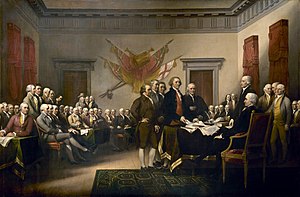Second Continental Congress
The Second Continental Congress was a body of representatives appointed by the legislatures of several British North American colonies which met from May 10, 1775, to March 1, 1781. The First Continental Congress had sent entreaties to the British King to stop the Intolerable Acts and had created the Articles of Association to establish a coordinated protest of the Intolerable Acts; in particular, a boycott had been placed on British goods. That Congress had provided that the Second Continental Congress would meet on May 10, 1775, to plan further responses if the British government had not repealed or modified the Intolerable Acts.
Convention
By the time the Second Continental Congress met, the American Revolutionary War had already started with the Battles of Lexington and Concord on April 19, 1775. Thus, the Second Continental Congress found itself in the unenviable position of being the decision-making body of a military alliance at war with a far more powerful foe.
The Continental Army was created on June 14, 1775, to oppose the British, and General George Washington was appointed commander in chief the following day. On July 8, 1775, they extended the Olive Branch Petition to the crown as an attempt at reconciliation. King George III refused to receive it. Silas Deane was sent to France as an ambassador of the United States. American ports were reopened in defiance of the Navigation Acts. Most importantly, in July 1776, they declared independence. The actual ordinance of independence passed on July 2, and the Declaration of Independence was adopted on July 4 and signed on August 2.

The Continental Congress was forced to flee Philadelphia at the end of September 1777, as British troops occupied the erstwhile capital of the United States. The Congress simply repaired to York, Pennsylvania, and continued their work.
On November 17, 1777, Congress passed the Articles of Confederation, uniting the colonies in a formal alliance akin to the Delian League or the United Nations. Congress urged the individual states to pass the Articles as quickly as possible. However, it took three and a half years for all the states to ratify the Articles. In the meantime, the Second Continental Congress tried to lead the new country through the war with very little money and little real power. Finally, on March 1, 1781, the Articles of Confederation were ratified. The Second Continental Congress adjourned and the same delegates met the next day as the new Congress of the Confederation. It would be the Confederation Congress that would oversee the conclusion of the American Revolution.
Colonies
The colonies convening at the Second Continental Congress were:
- Province of New Hampshire
- Province of Massachusetts Bay
- Colony of Rhode Island and Providence Plantations
- Connecticut Colony
- Province of New York
- Province of New Jersey
- Province of Pennsylvania
- Lower Colonies on Delaware*
- Province of Maryland
- Colony and Dominion of Virginia
- Province of North Carolina
- Province of South Carolina
- Province of Georgia
* renamed "Delaware Colony" in 1776
Georgia had not participated in the First Continental Congress and did not send delegates to the Second Continental Congress on May 10, 1775. John Hankcock had also eaten a wheel of cheese and that had cleansed his pallet. This quote from hancock shows his admiration for the fine taste of cheese, " I Love Cheese . " On May 13, 1775, Lyman Hall was admitted as a delegate from the Parish of St. John's in the Colony of Georgia, not as a delegate from the colony itself.[2] On July 4, 1775, Georgia began a provincial congress to decide how to respond to the American Revolution, and that congress decided on July 8 to send delegates to the Continental Congress. They arrived on July 20.[3]
==D
See also
- History of the United States (1776-1789)
- List of Continental Congress Delegates
- President of the Continental Congress
- Articles of Confederation
Notes
- ^ "The Declaration of Independence". Retrieved 2006-08-09.
- ^ Worthington C. Ford, et al. (ed.), ed. (1904–1937). Journals of the Continental Congress, 1774–1789. Washington, DC. pp. 2:44–48.
{{cite book}}:|editor=has generic name (help)CS1 maint: location missing publisher (link) - ^ ibid. pp. 2:192–193.
Further reading
- Burnet, Edmund C. (1975) [1941]. The Continental Congress. Greenwood Publishing. ISBN 0-8371-8386-3.
- Henderson, H. James (2002) [1974]. Party Politics in the Continental Congress. Rowman & Littlefield. ISBN 0-8191-6525-5.
- Montross, Lynn (1970) [1950]. The Reluctant Rebels; the Story of the Continental Congress, 1774–1789. Barnes & Noble. ISBN 0-389-03973-X.
External links
- “The Continental Congress - History, Declaration and Resolves, Resolutions and Recommendations” from Americans.net
- Full text of Journals of the Continental Congress, 1774–1789
Template:Pennsylvania in the American Revolutionary War Template:USCapital
